Regain Your Health in Under 2 Weeks
Note: our life-changing 12-Day Programs are fully booked. Join the waitlist for plant-based tips and to be the first to hear when new dates open.
The 12-Day McDougall Program is a life-saving online medical program that has been reversing and healing chronic illness for over 40 years through expert medical care, world-class education and whole food, starch-based nutrition.
Our program is 100% online and includes all education and care during the 12 days together, as well as a full year of support from your dedicated Support Specialist. Once enrolled, you’ll schedule your first appointment with our Medical Director, Anthony Lim, MD, JD, to kickstart your health journey.

The 12-Day McDougall Program is the most powerful and transformative experience we've offered in our 50+ years of practice. Will you join us to regain your health?
Here's what participants have to say:
Incredible transformations
In just 12 days, participants experienced amazing changes in their lives:
- 90% of participants were able to reduce or eliminate unnecessary medications
- Participants lost an average of 4 pounds in only 12 days while eating unrestricted amounts of the right foods
- Relief of chronic fatigue is experienced by 80% of participants
- Relief of intestinal distress from indigestion to constipation to chronic diarrhea
- More than a 22 mg/dL reduction in cholesterol
- Relief of chest pain (angina) in most people with narrowed heart arteries (atherosclerosis)
- Lessening and elimination of swelling and pain from inflammatory arthritis
- Lower blood sugar and relief of peripheral neuropathy (pain in the legs and feet). Almost all participants with type 2 diabetes are cured of their diseases after achieving ideal body weight
- Improved complexion with reduction in oily skin and hair
- 100% of participants said they feel equipped with the tools and knowledge to be successful in reaching their long-term health goals
You should expect the same transformational results. These benefits only continue over the weeks, months and years that follow your time with us.
See what others have to say about the 12-Day McDougall Program experience.
Life-saving care from the comfort of your home
The 12-Day McDougall Program brings professional care right into your home. Our board-certified physicians, alongside the entire McDougall team, will empower you with real-world nutritional guidance, easy cooking demonstrations, practical exercise routines, psychological support and compassionate support to begin to heal chronic diseases such as:
- Diabetes
- Heart disease & atherosclerosis
- Osteoporosis
- Liver disease
- Obesity
- Arthritis & autoimmune diseases
- GI (bowel) diseases
- High blood pressure
- High cholesterol
- Cancer
- Kidney disease
- Multiple sclerosis
- Depression
Learning from home will allow you to immediately apply what you’ve learned, practice in your own kitchen and get direct guidance from the McDougall team as questions come up. This is the exact environment where you’ll be challenged in your everyday life, and we’ll be there with you every step of the way. We’re here to set you up for lasting success.
We limit attendance to 50 participants per program to provide you with the attention and support you need for these powerful changes to your lifestyle.
Here is what’s possible for you with the 12-Day McDougall Program:
- Avoid dangerous and costly surgeries
- Lower, or eliminate, unnecessary medications and avoid their harmful side effects
- Save time and money with fewer doctor’s visits and less time off work
- Live a full life with vitality and confidence in your good health
- Add healthy years to your life plus keep up with your kids, your grandchildren and enjoy that bucket list trip you’ve always dreamed about
How we’ll work together
We’ve worked with thousands of patients over the last 40 years to develop and refine the most effective life-changing tools that successfully reverse and heal chronic diseases. As a member of the 12-Day McDougall Program, you’ll have access to:
Personal Medical Care: Our medical director Anthony Lim, MD, JD will meet with you in a private one-on-one medical appointment to review your bloodwork, discuss your health goals and identify the steps you can take to reach them. Additional time can be scheduled at your request for an additional fee.
Live Interactive Lectures: Anthony Lim, MD, JD; Jeff Novick, MS, RDN; Doug Lisle, PhD; Jack Dixon, NSCA, CPT; Chef AJ; Heather McDougall and other McDougall-certified experts will present live lectures on topics essential for your understanding of the McDougall Program. These lectures will cover chronic illnesses and diseases, nutrition, exercise, meal planning, overcoming emotional eating, behavioral change and much more—you’ll learn everything you need to achieve optimal health and nutrition.
1-on-1 Meetings with a Dedicated Support Specialist: You’ll be assigned a dedicated Support Specialist who will meet with you each day of the program to answer any questions you have, challenges you’re facing and more. This is your time to discuss your progress and problems.
Ongoing Support: The McDougall Program is designed for lifelong changes. To ensure you meet your health goals, your dedicated Support Specialist will offer ongoing support with weekly, then monthly check-ins. Ongoing support is for one full year following the program.
You’ll also receive:
- A health assessment to monitor your progress over the course of the program
- Q&A sessions after each lecture to personally engage with our team in an interactive and intimate setting
- Weekly virtual meetings with fellow graduates for additional support after the program
- A delicious 12-day meal plan to follow throughout the program
- Cooking demonstrations of our favorite and most popular whole food, starch-based recipes
- A passionate and supportive community of people who are on the same path, as well as seasoned McDougallers who can share their experiences and best practices for continued success
- An official discharge letter from our doctor, addressed to you. This letter will summarize your time with us and will include specific reasons why we have asked you to change your medications, as well as all other recommendations for your doctor, including our dietary guidelines
A day in the life of the 12-Day McDougall Program:
6:00 AM – 8:00 AM: CHECK IN with your dedicated Support Specialist to discuss general wellness and any questions you have. This just takes a few minutes and will be scheduled at a time that works for you.
7:00 AM: MEET UP with fellow participants over breakfast and get to know each other.
9-9:45 AM: Q&A with the McDougall Team. Get exclusive access to ask all of your questions about healing and reversing chronic illness and disease, whole food, starch-based nutrition, how to make permanent changes to your lifestyle and more.
10-11:30 AM: LECTURE | NUTRITION with Jeff Novick, MS, RDN, LDN. Learn how to read food labels, what to eat and what not to eat to lose weight, and product recommendations to successfully transition to a whole food, starch-based lifestyle.
3-3:45 PM: CHAT | CONNECT with guest chefs as well as seasoned McDougallers who share their tips and best practices for ongoing success.
4-5:30 PM: LECTURE | BEHAVIORAL CHANGE with Anthony Lim, MD, JD. Learn about the behavioral changes that lead to finally changing the way you eat. For good this time.
McDougall Program participants: 12-Day Program was “Life-Changing”
“Now I measure my success by my outlook, my ability to make choices and self-talk”
Janet feels more in control of herself and her choices and has more self-awareness.
“I can’t remember the last time I felt this good.“
Kathryn has more energy and stamina for doing things she loves to do.
“One of the best investments I ever made.”
Peggy said it’s never too late!

Ready to do this together?
We will teach and guide you through everything we have come to know and understand about the underlying cause of chronic illness and disease, and how to reverse them. Through education and compassionate care, we’ll provide you with the tools you need to make permanent positive changes to your health.
Now, more than ever, the McDougall Program can help you stay safe and healthy. Are you ready?
If you would like someone to join you, please email us at office@drmcdougall.com for information about our Friends & Family Offer. Please note this is only available to those who have already booked the 12-Day McDougall Program.
Questions? Click here for the FAQs.











